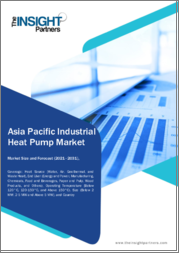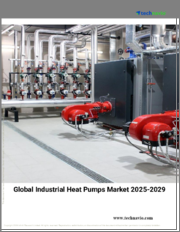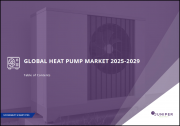
|
시장보고서
상품코드
1451232
히트 펌프 시장 보고서 : 정격 용량별, 제품 유형별, 최종 용도 분야별, 지역별(2024-2032년)Heat Pumps Market Report by Rated Capacity, Product Type, End Use Sector, and Region 2024-2032 |
||||||
세계의 히트 펌프 시장 규모는 2023년 592억 달러에 달했습니다. IMARC Group은 향후 2024년부터 2032년까지 8.4%의 성장률(CAGR)을 보일 전망이며 2032년에는 1,250억 달러에 달할 것으로 예측했습니다. 종래 에너지원의 비용 상승, 태양광 발전이나 풍력 발전과 같은 신재생 에너지원의 채용 증가, 신축 주택의 건설 활동의 활성화 등이 시장을 뒷받침하는 주요 요인이 되고 있습니다.
히트 펌프는 한 곳에서 다른 곳으로 열을 이동시키는 에너지 효율적인 시스템입니다. 히트 펌프는 커패시터, 압축기, 증발기, 팽창 밸브로 구성되며 효율적으로 작동합니다. 히트 펌프는 공기, 땅, 물 등의 저온 열원에서 열을 꺼내 집과 같은 고온 장소로 이동시켜 작동합니다. 일반적으로 주택과 상업용 건물의 냉난방에 사용됩니다. 히트 펌프는 연소에 의해 열을 발생시키는 것보다 기존의 열원을 이용하기 때문에 환경 친화적이고 비용 효율적인 것으로 알려져 있습니다.
석유 및 가스 등 전통적인 에너지원의 비용이 상승하고 있기 때문에 세계 사람들이 히트펌프와 같은 에너지 효율적인 선택을 모색하고 있습니다. 게다가 태양광 발전과 풍력 발전과 같은 신재생 에너지원의 채용이 증가하고 있는 것도 시장 성장을 뒷받침하고 있습니다. 또한 에너지 효율 및 환경 부하 감소와 같은 히트 펌프의 이점에 대한 개인적인 의식 증가가 시장에 긍정적인 영향을 미칩니다. 이와는 별도로, 신축 주택과 집합 주택의 건설 활동이 활발해지고 있는 것도, 히트 펌프와 같은 냉난방 솔루션 수요를 세계적으로 밀어 올리고 있습니다. 게다가 건물의 넷제로 에너지 소비의 달성에 대한 관심의 고조가, 에너지 사용과 배출을 최소한으로 억제하는 히트 펌프의 채용에 박차를 가하고 있습니다.
히트 펌프 시장 동향 및 촉진요인 :
에너지 효율적인 제품 증가
지속가능성 및 에너지 절약에 대한 관심 증가는 히트 펌프 수요의 중요한 촉진요인입니다. 히트 펌프는 열을 발생시키는 것이 아니라 열을 이동시킴으로써 공간을 따뜻하게 하거나 식히는 효율이 높고, 종래의 시스템에 비해 에너지 소비량이 적습니다. 이는 이산화탄소 배출량을 줄이고 에너지 효율을 높이는 세계의 노력과 일치합니다.
기후 변화에 대한 관심 증가
기후 변화 및 환경에 미치는 영향에 대한 인식이 높아지면 히트 펌프와 같은 친환경 솔루션에 대한 수요가 급증하고 있습니다. 사람들과 기업이 이산화탄소 배출량을 줄일 수 있도록, 히트 펌프는 화석연료를 이용한 냉난방 시스템을 대체할 수 있는 지속가능한 옵션을 제공합니다.
범용성 및 적응성 향상
히트 펌프는 단일 시스템에서 난방 및 냉방 기능을 제공함으로써 다용도를 제공합니다. 다양한 기후 조건과 냉난방 요구에 대응할 수 있기 때문에 다양한 기상 패턴을 가진 지역에 매력적인 선택이 되어, 다양한 지역에서 수요를 촉진하고 있습니다.
목차
제1장 서문
제2장 조사 범위 및 조사 방법
- 조사 목적
- 이해관계자
- 데이터 소스
- 1차 정보
- 2차 정보
- 시장 추정
- 상향식 접근
- 하향식 접근
- 조사 방법
제3장 주요 요약
제4장 서문
- 개요
- 주요 산업 동향
제5장 세계의 히트 펌프 시장
- 시장 개요
- 시장 실적
- COVID-19의 영향
- 시장 내역 : 정격 용량별
- 시장 내역 : 제품 유형별
- 시장 내역 : 최종 용도 분야별
- 시장 내역 : 지역별
- 시장 예측
제6장 SWOT 분석
- 개요
- 강점
- 약점
- 기회
- 위협
제7장 밸류체인 분석
제8장 Porter's Five Forces 분석
- 개요
- 구매자의 협상력
- 공급기업의 협상력
- 경쟁도
- 신규 참가업체의 위협
- 대체품의 위협
제9장 시장 내역 : 정격 용량별
- 10kW 미만
- 시장 동향
- 시장 예측
- 10-20kW
- 시장 동향
- 시장 예측
- 20-30 kW
- 시장 동향
- 시장 예측
- 30kW초
- 시장 동향
- 시장 예측
제10장 시장 내역 : 제품 유형별
- 공기 열원 히트펌프
- 시장 동향
- 시장 예측
- 지상 열원 히트 펌프
- 시장 동향
- 시장 예측
- 수열원 히트 펌프
- 시장 동향
- 시장 예측
- 배열 히트 펌프
- 시장 동향
- 시장 예측
- 기타
- 시장 동향
- 시장 예측
제11장 시장 내역 : 최종 용도 분야별
- 주택
- 시장 동향
- 시장 예측
- 상업
- 시장 동향
- 시장 예측
- 접객
- 시장 동향
- 시장 예측
- 소매
- 시장 동향
- 시장 예측
- 교육
- 시장 동향
- 시장 예측
- 음식
- 시장 동향
- 시장 예측
- 종이 및 펄프
- 시장 동향
- 시장 예측
- 화학제품 및 석유화학제품
- 시장 동향
- 시장 예측
- 기타
- 시장 동향
- 시장 예측
제12장 시장 내역 : 지역별
- 유럽
- 시장 동향
- 시장 예측
- 북미
- 시장 동향
- 시장 예측
- 아시아태평양
- 시장 동향
- 시장 예측
- 중동 및 아프리카
- 시장 동향
- 시장 예측
- 라틴아메리카
- 시장 동향
- 시장 예측
제13장 가격 분석
제14장 경쟁 구도
- 시장 구조
- 주요 기업
- 주요 기업 프로파일
- Daikin Industries, Ltd
- Mitsubishi Electric Corporation
- MIDEA GROUP
- NIBE Industrier AB, Corp
- Ingersoll Rand
- Danfoss
- Panasonic Corporation
- GDC Group Limited
- Viessmann Manufacturing Company Inc
- Robert Bosch GmbH
- United Technologies Corporation
The global heat pumps market size reached US$ 59.2 Billion in 2023. Looking forward, IMARC Group expects the market to reach US$ 125.0 Billion by 2032, exhibiting a growth rate (CAGR) of 8.4% during 2024-2032. The increasing cost of traditional energy sources, rising adoption of renewable energy sources like solar and wind power, and the growing construction activities of new homes are some of the major factors propelling the market.
Heat pumps are energy efficient systems that transfer heat from one place to another. They comprise condensers, compressors, evaporators, and expansion valves for their efficient functioning. They work by extracting heat from a lower-temperature source, such as the air, ground, or water, and then transferring it to a higher-temperature area, like home. They are commonly used for heating and cooling purposes in residential and commercial buildings. They are known for their environment-friendly nature and cost effectiveness, as heat pumps utilize existing heat sources than generating heat through combustion.
The increasing cost of traditional energy sources, such as oil and gas, is prompting people to explore more energy-efficient options like heat pumps around the world. Moreover, the rising adoption of renewable energy sources like solar and wind power is favoring the growth of the market. In addition, the growing awareness among individuals about the benefits of heat pumps, including their energy efficiency and reduced environmental impact, is influencing the market positively. Apart from this, increasing construction activities of new homes and residential complexes are driving the demand for heating and cooling solutions like heat pumps worldwide. Furthermore, the rising interest in achieving net-zero energy consumption in buildings is spurring the adoption of heat pumps, which align to minimize energy use and emissions.
Heat Pumps Market Trends/Drivers:
Increase in energy efficient products
The rising focus on sustainability and energy conservation is a significant driver for heat pump demand. Heat pumps are highly efficient in heating and cooling spaces by transferring heat rather than generating it, consuming less energy compared to traditional systems. This aligns with global efforts to reduce carbon emissions and enhance energy efficiency.
Rise in climate change concerns
The rising awareness about climate change and its impact on the environment has led to a surge in demand for environment friendly solutions like heat pumps. As people and businesses seek to reduce their carbon footprint, heat pumps offer a sustainable alternative to fossil fuel-based heating and cooling systems.
Growing versatility and adaptability
Heat pumps offer versatility by providing heating and cooling capabilities in a single system. This adaptability to varying climate conditions and heating or cooling needs makes them an appealing choice for regions with diverse weather patterns, thereby driving demand across different geographical areas.
Heat Pumps Industry Segmentation:
IMARC Group provides an analysis of the key trends in each segment of the global heat pumps market report, along with forecasts at the global and regional levels from 2024-2032. Our report has categorized the market based on rated capacity, product type and end use sector.
Breakup by Rated Capacity:
Up to 10 kW
10-20 kW
20-30 kW
Above 30 kW
Up to 10 kW dominates the market
The report has provided a detailed breakup and analysis of the market based on the rated capacity. This includes up to 10 kW, 10-20 kW, 20-30 kW and above 30 kW. According to the report, up to 10 kW heat pumps represented the largest segment. Heat pumps in this range are suitable for smaller spaces and residential applications, which provide efficient heating and cooling for homes with lower energy demands.
Heat pumps falling within this range have a rated capacity between 10 and 20 kilowatts. They are well-suited for larger homes or small commercial spaces, which offer more substantial heating and cooling capabilities compared to smaller models.
Heat pumps in this category possess a rated capacity ranging from 20 to 30 kilowatts. They are designed for larger commercial buildings or spaces with higher heating and cooling requirements. These systems can effectively maintain comfortable indoor temperatures in larger environments.
Breakup by Product Type:
Air Source Heat Pump
Ground Source Heat Pump
Water Source Heat Pump
Exhaust Air Heat Pump
Others
Air source heat pump holds the largest share in the market
A detailed breakup and analysis of the market based on the product type has also been provided in the report. This includes air source heart pump, ground source heat pump, water source heat pump, exhaust air heat pump, and others. According to the report, air source heat pump accounted for the largest market share. Air source heat pumps extract heat from the ambient air outside and use it to heat indoor spaces. They are commonly used in residential and commercial buildings and are known for their versatility and ease of installation. Air source heat pumps can also be used for cooling by reversing the process.
Ground source heat pumps, also known as geothermal heat pumps, utilize the relatively stable temperature of the ground or groundwater as a heat source or sink. They are highly efficient and can provide consistent heating and cooling throughout the year. These systems require a ground loop installation, which involves burying pipes underground to facilitate heat exchange.
Water source heat pumps extract heat from a water source, such as a lake, river, or well, for heating or cooling purposes. They offer efficient performance in areas with access to a water source with relatively stable temperatures.
Breakup by End Use Sector:
Residential
Commercial
Hospitality
Retail
Education
Food & Beverage
Paper & Pulp
Chemicals & Petrochemicals
Others
Residential dominates the market
The report has provided a detailed breakup and analysis of the market based on the end use sector. This includes residential, commercial, hospitality, retail, education, food and beverage, paper and pulp, chemicals and petrochemicals, and others. According to the report, residential represented the largest segment. Heat pumps are commonly used in residential settings to provide heating and cooling for homes. They offer energy-efficient climate control, ensuring comfort while minimizing energy consumption and environmental impact.
Heat pumps are widely utilized in commercial buildings, such as offices, malls, and other non-industrial spaces. They help maintain comfortable indoor temperatures for occupants and customers, contributing to a pleasant environment.
The hospitality industry, including hotels and resorts, benefits from heat pumps for heating and cooling guest rooms, common areas, and facilities. Heat pumps enable establishments to provide a comfortable stay for guests while managing energy costs.
Breakup by Region:
Europe
North America
Asia Pacific
Latin America
Middle East and Africa
Asia Pacific exhibits a clear dominance, accounting for the largest heat pumps market share
The market research report has also provided a comprehensive analysis of all the major regional markets, which include Europe, North America, Asia Pacific, Latin America, and Middle East and Africa. According to the report, Asia Pacific accounted for the largest market share.
The increasing sales of heating, ventilation, and air conditioning (HVAC) systems represent one of the primary factors driving the demand for heat pumps in the Asia Pacific region. Moreover, the rising adoption of green buildings is favoring the growth of the market in the region. Besides this, the growing popularity of dual source heat pumps is influencing the market positively in the region.
Competitive Landscape:
The leading companies are incorporating variable speed compressors that adjust their speed according to the heating or cooling demand, which results in improved efficiency and precise temperature control. They are also integrating smart thermostats and control systems that allow users to remotely monitor and adjust heat pump settings through smartphones or other devices. This leads to better energy management and personalized comfort. Moreover, leading players are using heat recovery systems that capture and repurpose waste heat generated during cooling or dehumidification processes. This reclaimed heat can be used for water heating or other applications, increasing overall system efficiency.
The report has provided a comprehensive analysis of the competitive landscape in the market. Detailed profiles of all major companies have also been provided. Some of the key players in the market include:
Daikin Industries, Ltd.
Mitsubishi Electric Corporation
MIDEA GROUP
NIBE Industrier AB, Corp.
Ingersoll Rand
Danfoss
Panasonic Corporation
GDC Group Limited
Viessmann Manufacturing Company Inc.
Robert Bosch GmbH
United Technologies Corporation
Recent Developments:
In 2022, Mitsubishi Electric Corporation launched a cascaded air source heat pump that can generate between 7.8 kW and 640 kW of heat. It can also produce hot water at a temperature of up to 70 C without boost heaters.
In 2023, Daikin Industries, Ltd recently announced a total investment of 300 million euros to construct new factory in Poland and start production of heat pumps in July 2024.
In 2022, MIDEA GROUP constructed a new base for the production and research and development of heat pumps in Feltre, a town of Veneto in northern Italy, to expand their international market.
Key Questions Answered in This Report
- 1. How big is the global heat pumps market?
- 2. What is the expected growth rate of the global heat pumps market during 2024-2032?
- 3. What are the key factors driving the global heat pumps market?
- 4. What has been the impact of COVID-19 on the global heat pumps market?
- 5. What is the breakup of the global heat pumps market based on the rated capacity?
- 6. What is the breakup of the global heat pumps market based on the product type?
- 7. What is the breakup of the global heat pumps market based on the end use sector?
- 8. What are the key regions in the global heat pumps market?
- 9. Who are the key players/companies in the global heat pumps market?
Table of Contents
1 Preface
2 Scope and Methodology
- 2.1 Objectives of the Study
- 2.2 Stakeholders
- 2.3 Data Sources
- 2.3.1 Primary Sources
- 2.3.2 Secondary Sources
- 2.4 Market Estimation
- 2.4.1 Bottom-Up Approach
- 2.4.2 Top-Down Approach
- 2.5 Forecasting Methodology
3 Executive Summary
4 Introduction
- 4.1 Overview
- 4.2 Key Industry Trends
5 Global Heat Pumps Market
- 5.1 Market Overview
- 5.2 Market Performance
- 5.3 Impact of COVID-19
- 5.4 Market Breakup by Rated Capacity
- 5.5 Market Breakup by Product Type
- 5.6 Market Breakup by End Use Sector
- 5.7 Market Breakup by Region
- 5.8 Market Forecast
6 SWOT Analysis
- 6.1 Overview
- 6.2 Strengths
- 6.3 Weaknesses
- 6.4 Opportunities
- 6.5 Threats
7 Value Chain Analysis
8 Porter's Five Forces Analysis
- 8.1 Overview
- 8.2 Bargaining Power of Buyers
- 8.3 Bargaining Power of Suppliers
- 8.4 Degree of Competition
- 8.5 Threat of New Entrants
- 8.6 Threat of Substitutes
9 Market Breakup by Rated Capacity
- 9.1 Up to 10 kW
- 9.1.1 Market Trends
- 9.1.2 Market Forecast
- 9.2 10-20 kW
- 9.2.1 Market Trends
- 9.2.2 Market Forecast
- 9.3 20-30 kW
- 9.3.1 Market Trends
- 9.3.2 Market Forecast
- 9.4 Above 30 kW
- 9.4.1 Market Trends
- 9.4.2 Market Forecast
10 Market Breakup by Product Type
- 10.1 Air Source Heat Pump
- 10.1.1 Market Trends
- 10.1.2 Market Forecast
- 10.2 Ground Source Heat Pump
- 10.2.1 Market Trends
- 10.2.2 Market Forecast
- 10.3 Water Source Heat Pump
- 10.3.1 Market Trends
- 10.3.2 Market Forecast
- 10.4 Exhaust Air Heat Pump
- 10.4.1 Market Trends
- 10.4.2 Market Forecast
- 10.5 Others
- 10.5.1 Market Trends
- 10.5.2 Market Forecast
11 Market Breakup by End Use Sector
- 11.1 Residential
- 11.1.1 Market Trends
- 11.1.2 Market Forecast
- 11.2 Commercial
- 11.2.1 Market Trends
- 11.2.2 Market Forecast
- 11.3 Hospitality
- 11.3.1 Market Trends
- 11.3.2 Market Forecast
- 11.4 Retail
- 11.4.1 Market Trends
- 11.4.2 Market Forecast
- 11.5 Education
- 11.5.1 Market Trends
- 11.5.2 Market Forecast
- 11.6 Food & Beverage
- 11.6.1 Market Trends
- 11.6.2 Market Forecast
- 11.7 Paper & Pulp
- 11.7.1 Market Trends
- 11.7.2 Market Forecast
- 11.8 Chemicals & Petrochemicals
- 11.8.1 Market Trends
- 11.8.2 Market Forecast
- 11.9 Others
- 11.9.1 Market Trends
- 11.9.2 Market Forecast
12 Market Breakup by Region
- 12.1 Europe
- 12.1.1 Market Trends
- 12.1.2 Market Forecast
- 12.2 North America
- 12.2.1 Market Trends
- 12.2.2 Market Forecast
- 12.3 Asia Pacific
- 12.3.1 Market Trends
- 12.3.2 Market Forecast
- 12.4 Middle East and Africa
- 12.4.1 Market Trends
- 12.4.2 Market Forecast
- 12.5 Latin America
- 12.5.1 Market Trends
- 12.5.2 Market Forecast
13 Price Analysis
14 Competitive Landscape
- 14.1 Market Structure
- 14.2 Key Players
- 14.3 Profiles of Key Players
- 14.3.1 Daikin Industries, Ltd
- 14.3.2 Mitsubishi Electric Corporation
- 14.3.3 MIDEA GROUP
- 14.3.4 NIBE Industrier AB, Corp
- 14.3.5 Ingersoll Rand
- 14.3.6 Danfoss
- 14.3.7 Panasonic Corporation
- 14.3.8 GDC Group Limited
- 14.3.9 Viessmann Manufacturing Company Inc
- 14.3.10 Robert Bosch GmbH
- 14.3.11 United Technologies Corporation



















